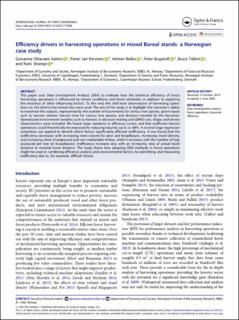| dc.contributor.author | Ottaviani Aalmo, Giovanna | |
| dc.contributor.author | Kerstens, Pieter Jan | |
| dc.contributor.author | Belbo, Helmer | |
| dc.contributor.author | Peter, Bogetoft | |
| dc.contributor.author | Talbot, Bruce | |
| dc.contributor.author | Strange, Niels | |
| dc.date.accessioned | 2021-01-12T11:41:01Z | |
| dc.date.available | 2021-01-12T11:41:01Z | |
| dc.date.created | 2020-07-22T09:13:19Z | |
| dc.date.issued | 2020-06-17 | |
| dc.identifier.citation | International Journal of Forest Engineering. 2020, . | en_US |
| dc.identifier.issn | 1494-2119 | |
| dc.identifier.uri | https://hdl.handle.net/11250/2722544 | |
| dc.description.abstract | This paper uses Data Envelopment Analysis (DEA) to evaluate how the technical efficiency of forest harvesting operations is influenced by terrain conditions and forest attributes, in addition to exploring the existence of other influencing factors. To this end, 643 shift-level observations of harvesting operations on 253 distinct harvested sites were used. The aim of this study is to highlight the harvester’s ability to maximize the outputs, represented by the number of assortments for various tree species, given inputs such as harvest volume, harvest time for various tree species, and distance traveled by the harvester. Operational environment variables such as harvest, or decision-making unit (DMU) size, shape, and terrain characteristics were included. We found large variations in efficiency scores, and that inefficient harvest operations could theoretically be improved by reducing input by up to ca. 80%. A second stage regression estimation was applied to identify which factors significantly affected inefficiency. It was found that the inefficiency decreases with increasing stem-volume for pine and broadleaves, increasing stand density, and increasing share of pulpwood and non-marketable timber, while it increases with the number of logs produced per tree (in broadleaves). Inefficiency increases also with an increasing ratio of actual travel distance to minimal travel distance. The study shows how adopting DEA methods in forest operations might be used in combining efficiency analysis and environmental factors, by identifying and measuring inefficiency due to, for example, difficult terrain. | en_US |
| dc.language.iso | eng | en_US |
| dc.publisher | Taylor & Francis Group | en_US |
| dc.rights | Attribution-NonCommercial-NoDerivatives 4.0 Internasjonal | * |
| dc.rights.uri | http://creativecommons.org/licenses/by-nc-nd/4.0/deed.no | * |
| dc.title | Efficiency drivers in harvesting operations in mixed Boreal stands: a Norwegian case study | en_US |
| dc.type | Peer reviewed | en_US |
| dc.type | Journal article | en_US |
| dc.description.version | publishedVersion | en_US |
| dc.rights.holder | © 2020 The Author(s) | en_US |
| dc.source.pagenumber | 13 | en_US |
| dc.source.journal | International Journal of Forest Engineering | en_US |
| dc.identifier.doi | 10.1080/14942119.2020.1778980 | |
| dc.identifier.cristin | 1820127 | |
| cristin.ispublished | true | |
| cristin.fulltext | original | |
| cristin.qualitycode | 1 | |

